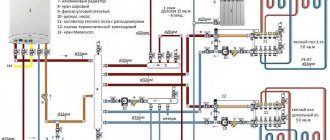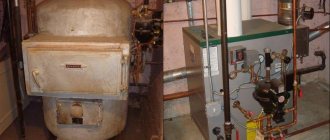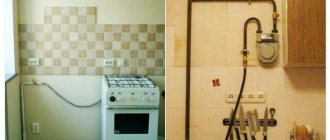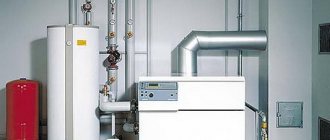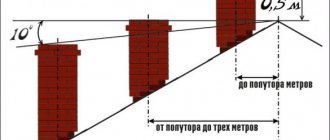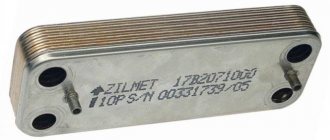Placing a gas boiler in a house is not an easy task. There are serious requirements that can disrupt a home owner's plans. After all, in order to put a gas boiler into operation, it is necessary to obtain permits. It is prohibited to use it without them. Unauthorized switching on of the heating unit will lead to large fines. The thing is that a gas boiler is a fire hazardous equipment.
Basic regulatory requirements for placement
Placing gas boilers in a private home is a serious matter. There are strict regulatory requirements that must be complied with without fail.
Here are some of them related to accommodation in a private house:
- The boiler must not be installed close to the wall. This also applies to wall-mounted models, which are equipped with special factory fasteners and canopies. Structurally, they are made so that there is a gap between the equipment and the wall of the house. You cannot use homemade fasteners.
- All boilers with an open combustion chamber must be equipped with a chimney, the installation of which has its own requirements. First of all, it should be as vertical as possible. Minor deviations are permitted. If the need arises, horizontal sections with a total length of 3 m can also be used. Bends are also not prohibited, but their number should not exceed 3 pieces.
- The diameter of the chimney must correspond to the diameter of the outlet pipe of the gas boiler.
- If volatile equipment is used, then it is necessary to strictly follow the grounding installation rules. They are usually indicated by the manufacturer in the instructions.
- A gas analyzer is a necessary element for the safe operation of a gas boiler. It is triggered when the amount of gas in the room increases in the form of a leak. When it is triggered, the gas supply to the boiler firebox is turned off using a shut-off valve. The latter receives a signal from the gas analyzer.
- Installation of a gas meter in front of the equipment is a prerequisite.
Requirements for obtaining permission to place a gas boiler and for the equipment acceptance certificate:
- You need to obtain technical specifications from the Raygas department. They give the owner of the house the right to begin installation work, place and install gas equipment. Therefore, you need to submit an application to Raigaz and support it with documents for the house and the right to own it.
- Gas workers give a response within 30 days. During this period, technical conditions must be prepared that will specify the daily gas consumption. If the owner of the house was refused, then Raigaz must indicate the reasons. You can appeal the refusal or correct the shortcomings and resubmit the application.
- After receiving the technical conditions, a project is created, which indicates the route of the gas pipeline, the location of the boiler, the connection point, etc. The project can only be produced by a specialized design bureau.
- The finished project is being agreed upon with the gas industry. The law allows up to 90 days for this.
- If the documentation is agreed upon, you can proceed to installation work.
- After completion of the work, the Raigas engineer must check compliance with the project, seal the gas meter and write an acceptance certificate in which he signs.
- After this, you can open the tap and use gas.
Choosing a heating scheme for a heating boiler in a private house
The boiler itself is only an element of the heating system. Without pipes and radiators through which the coolant circulates, its work is useless. Therefore, heating wiring must be provided in advance, before purchasing a unit that produces heat. The task is made easier by the fact that the heating circuit for all types of boilers has more similarities than differences.
Gravity diagram
Most often, this scheme is used for connection with a solid fuel or liquid boiler. If we approach the issue strictly, taking into account the preservation of efficiency, then modern gas boilers do not require gravity circulation of the coolant. Many wall-mounted and floor-mounted models with electronic control already have a built-in circulation pump, which forcibly drives water or antifreeze through pipes and radiators. In conditions of frequent power outages, such a boiler will be inactive.
General view of the gravitational scheme
However, in many houses, gravity circuits continue to operate in conjunction with a simple gas non-volatile boiler with mechanical control. By using large diameter heating pipes, the system creates sufficient water pressure to start the gas burner. In old systems, pipes with a cross-section of 100 - 150 mm were used, which encircled the rooms around the perimeter. The heat transfer of such a design is low, but it itself is reliable and durable. When installing radiators, the diameter of the supply pipes must be at least 40 mm to reduce hydrodynamic resistance.
In gravity systems, an expansion tank is a mandatory element. If the water in the system reaches high temperatures, excess water enters the tank due to the increased volume. The tank insures the system against leaks and depressurization in the event of an abrupt increase in pressure. In open-type systems, the tank is always located at the top point.
The gravity circuit is single-pipe. This means that the coolant sequentially passes through all the radiators, and then returns through the “return”. To install batteries in such a system, bypasses are used - bypass pipes with shut-off valves, thanks to which it is possible to dismantle and replace batteries without stopping the boiler and draining the coolant. Also, a Mayevsky valve is installed on each radiator to bleed the air that accumulates inside the wiring.
Mayevsky crane
Forced circulation circuit
The only disadvantage of this type of heating wiring is the dependence on the presence of voltage in the household electrical network. In addition to the boiler, the second important component of such a scheme is the circulation pump, which cuts into the “return” before returning it to the boiler. Modern pumps are silent, efficient and consume electricity like an incandescent light bulb. But thanks to this device, it becomes possible to make a choice in favor of a two-pipe system. In this case, the piping pipe passes through all heated rooms of the house. From it, a separate stream of hot water is supplied to each battery, and from it the cooled coolant is drained into the “return”, which is the very second pipe in the circuit. This allows you to distribute heat evenly across all radiators and maintain the same temperature even in the rooms furthest from the boiler.
If there is a circulation pump, the expansion tank must be closed so that a certain pressure can be created in the system. In case of exceeding normal values, an emergency pressure relief valve is provided.
Visual representation of a two-pipe circuit
In both schemes, a make-up unit must be provided through which coolant is poured into the system. If water is used, then a pipe from the water supply network is cut in to fill the pipelines, installing a filtration system at the inlet. When using antifreeze, an inlet valve with shut-off valves is installed, and injection is carried out using a “baby” submersible pump or other pumping equipment.
Required documents
To obtain technical conditions, the following documents must be attached to the application:
- passport of the gas boiler, which comes with it in packaging from the manufacturer;
- installation and operating instructions;
- quality certificate;
- a certificate stating that the boiler complies with the standards and requirements put forward by the state in relation to gas equipment.
For private houses, Raigas often offer to issue a technical certificate for the premises where the boiler will be placed. This document records the purpose of the room. That is, it is now either a boiler room or a furnace room. Separate buildings fit the definition of the first. For the second, premises built into the house or attached to it.
Prices: summary comparison table
Next, consider a comparative table of the cost of some external gas boilers of various modifications.
| Model | power, kWt | Price, thousand rubles |
| Phoenix-40 | 40 | 225 |
| Phoenix-60 | 60 | 235 |
| Phoenix-100 | 100 | 250 |
| Phoenix-200 | 200 | 365 |
| Phoenix-300 | 300 | 425 |
| Phoenix-400 | 400 | 490 |
| Phoenix-500 | 500 | 515 |
| RS-H-40 | 40 | 230 |
| RS-H-150 | 150 | 350 |
| RS-H-300 | 300 | 695 |
| RS-H-600 | 600 | 905 |
| RS-H-1000 | 1000 | 1100 |
Place and characteristics of the premises for accommodation
The requirements are strictly checked by representatives of Raigaz:
- A gas boiler for heating must be placed in a specially designated room. It can be located anywhere in the building: attic, basement, utility room, extension.
- It is prohibited to construct suspended ceilings and false floors in the boiler room. The reason is to avoid creating voids where gas can accumulate.
- The volume of the room is at least 8 m³, its area is at least 4 m², and the ceiling height is at least 2.5 m.
- A window in a boiler room is a mandatory attribute. Its size is 0.5 m². If the volume of the room is more than 15 m³, then the window area increases by 0.03 m³, taking into account each added cubic meter to the volume of the room.
- The width of the entrance door to the boiler room is 0.8 m. There should be a gap of 2.5 cm below between the door leaf and the floor.
- The boiler room must be built and finished only with fire-resistant materials.
All these rules for placing a gas boiler in a private house are necessary to ensure air exchange in the boiler room, which is equal to three times the volume of the room. The fire safety of the facility is also taken into account.
If a gas boiler with a closed combustion chamber is placed in the house, then some of the above requirements for the equipment do not apply. This mainly concerns the volume of air exchange and the room itself. Indeed, in units of this type, air is supplied using a fan directly from the street.
Installation restrictions
For safety reasons, appliances operating on gas fuel are prohibited from being installed in the following premises:
- in which there are no ventilation systems;
- in dormitories (rooms);
- in bathrooms;
- in the corridors and on the balcony;
- in basements;
- on the ground floor;
- on flammable wall surfaces.
One important clarification regarding installation on the ground floor and basement: installation is only permissible in a private single-apartment house, i.e. if the house is not divided into several owners.
Chimneys and ventilation
Properly installed ventilation is the key to the boiler room being accepted into operation. The question of whether a window in a boiler room is sufficient or whether the placement of a hood is necessary worries many. It should be noted that it is better to install a hood.
Fire safety rules and regulations change every year. All the time, some additions are being made that will have to be implemented anyway, sooner or later.
Therefore, it is recommended to install an exhaust device opposite the gas boiler, closer to the ceiling. This can be regular natural ventilation or forced. The main thing is to accurately match the size of the hood with the power of the gas boiler for the home. Here the ratio is: for every 1 kW of power there is 8 cm² of exhaust vent.
The requirements for the placement and location of the chimney were discussed above. If the flue pipe passes through the ceilings, then a fire-retardant coupling must be installed in the passage section. For example, this could be a tunnel through the ceiling through which a chimney passes, filled with fire-resistant material: expanded clay, asbestos, etc. It is important here that the pipe does not touch the flammable material of the house floor.
Technical requirements for equipment
There are no special requirements for the gas equipment itself. If the boiler has a quality certificate, then you can safely install it in the house. Sometimes representatives of Raygaz may make claims regarding certain characteristics. For example, to power. For small private houses, a boiler with a capacity of 30 kW is the maximum permissible limit. There is no point in installing more than this.
Floor type
Installing a floor-standing boiler is also not difficult, you need:
- Prepare a strong pedestal that can support the weight of the boiler. This is usually done by pouring a concrete solution, sometimes a sheet of galvanized iron is securely laid on the floor.
- Install the boiler, leveling its position using a building level.
- Connect the chimney to the unit, check the draft if there is no forced exhaust.
- Connect the device to the heating system by installing a filter at the end of the outlet line, i.e. just before the entrance.
Installation features
If this is a wall-mounted option, then only on factory mounting structures. If it is a floor model, then on a solid base: level, without flaws. This can be a pure concrete floor or covered with a fire retardant durable finish such as ceramic tiles.
The gas pipe is only steel. It is connected to the boiler through a flexible metal insert. But here you need to choose a corrugated hose designed specifically for gas, and not for water.
Piping the heating system, as well as connecting to the water supply network, can be made from different types of pipes, where polypropylene is the priority today.
The temperature in the boiler room, both during installation of equipment and during its operation, should not fall below 0º.
If the unit is volatile, then an outlet should be placed near it.
How to install a solid fuel boiler
Such devices give off heat by burning solid fuel. Most often, firewood is used as fuel. Solid fuel boilers are good because in the absence of access to gas and other resources, it becomes indispensable, since it can be heated even with suitable materials at hand.
The disadvantages of this design are as follows:
- Increased inertia. Today there are no methods to instantly extinguish burning solid fuel in a firebox.
- Formation of condensation. It occurs in the firebox when coolant with a temperature below 50°C enters the boiler tank.
Connecting an indirect heating boiler
If the heating system is built on the basis of a single-circuit boiler, it is necessary to determine the source of hot water. The simplest solution is to install a regular electric boiler in your home. But it will consume expensive electricity, which is not very profitable. It is much cheaper to connect an indirect heating boiler to the heating circuit.
The easiest way to connect a boiler to a boiler is to install small collectors and connect to them a pipe with a circulation pump and a check valve, which will go to the water heater, as well as a return pipe. By controlling the operation of the circulation pump, the boiler will turn the coolant supply on and off, regulating the temperature in the built-in tank. It is also possible to implement this circuit without a collector.
If, in addition to the boiler, additional circuits and heated floors are connected to your heating system, then you cannot do without collectors or a water gun.
What it is?
An autonomous heating system involves a complete rejection of central heating.
That is, it will be necessary to dismantle the radiators and pipes related to this system. The basis of individual heating in this case will be gas or electric boilers. And to them, in turn, new pipes and batteries should be attached. The principle of operation of boilers is quite simple - they heat water and send it to circulate through the created system, thereby heating the premises in the required mode.
Scheme with an additional heat exchanger
This boiler connection scheme is in demand when there is a need to completely waterproof individual circuits of the heating system. This need arises when using various coolants in circuits. That is, water can move in one, and antifreeze in the other.
The harness shown in various photos looks like this:
- Boiler.
- Heat exchanger.
- Various heating circuits.
- Safety elements installed on each circuit, a circulation pump, a drain valve and a make-up valve.
The heat exchanger is a heat accumulator with at least three coils. One circulates water heated in the boiler, and the other two circulate various types of coolants. Heat from the first coil is transferred to the others through the water in which they are located.
The benefit of an additional heat exchanger also lies in the ability to combine open and closed systems. The first is safer for the operation of the boiler, the second is more gentle for radiators.
